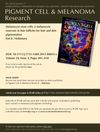Search
forLearn
3 / 3 resultslearn Osteopontin
signaling protein that, when suppressed, may grow hair by reducing inflammation and stem cell loss
learn Melatonin
hormone commonly taken for sleep aid has some topical benefits for hair
Research
5 / 1000+ results
research Melanocyte Stem Cells: A Melanocyte Reservoir in Hair Follicles for Hair and Skin Pigmentation
Melanocyte stem cells in hair follicles are key for hair color and could help treat greying and pigment disorders.

research Transplantation of Melanocyte Stem Cells in Vitiliginous Skin
Transplanting melanocyte stem cells from hair follicles can effectively treat vitiligo.

research Preservation of Melanoblasts in White Hair Follicles of Segmental Vitiligo Lesions: A Preliminary Study
White hair follicles in vitiligo have fewer and less functional melanocytes.
research Phototherapy and Chemotherapy in Vitiligo Treatment
Phototherapy is effective in treating vitiligo.

research Regulation of Melanocyte Stem Cell Behavior by the Niche Microenvironment
The environment around melanocyte stem cells is key for hair regeneration and color, with certain injuries affecting hair color and potential treatments for pigmentation disorders.
Community Join
5 / 16 resultscommunity Is there any new drug that looks promising ?
The conversation discusses GT20029, a drug in Phase II trials that targets androgen receptors with minimal systemic effects, and TDM-105795, a growth stimulant with a different mechanism than minoxidil that may revive papilla stem cells. Both are potential new treatments for hair loss.
community Growing hair witch capsaicin and occasional topical minoxidil
A user shared their experience using capsaicin from chili peppers and occasional topical minoxidil to promote hair growth, noting noticeable improvements without significant side effects. They previously experienced side effects from dutasteride and minoxidil but found the new regimen effective and manageable.
community What new hair-loss treatments actually look exciting right now (Oct 2025)
New hair loss treatments include Breezula, PP405, ET-02, KX-826, GT20029, VDPHL01, and CosmeRNA, with some showing promise in reactivating stem cells and reversing greying. Breezula and VDPHL01 are highlighted as potential add-ons or alternatives to current treatments like finasteride and minoxidil.
community New Hair Loss Treatment: Adipose Derived Secretomes
Adipose-derived stem cell secretome showed significant improvement in hair density and growth, especially when combined with minoxidil, suggesting a synergistic effect. The study had limitations, including a small sample size and potential bias.
community Great news recently for people with hairloss!
A potential treatment for alopecia involving a protein that calms hair follicles has shown promise in rats, but skepticism remains about its applicability to humans. Many users express doubt about the timeline for effective hair loss treatments, comparing it to past unfulfilled promises.